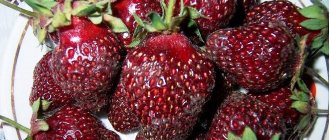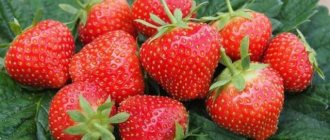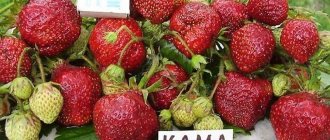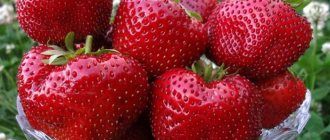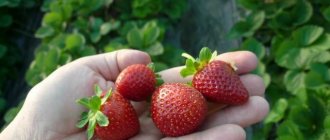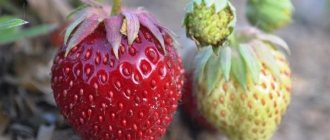Home / Garden / Berries
Back
Published: December 13, 2019
Reading time: 8 min
0
Garden strawberries with a name unfamiliar to the Russian ear - “Bogota” - are not new to domestic gardens. But for gardeners who are not yet familiar with the berries of Dutch selection, the description of the variety is interesting due to the characteristics of the fruits with large sizes and excellent taste.
In Russia, Bogota strawberries took root in the early 2000s. The originators of the variety were specialized institutes of the North Caucasus. And although the crop is recommended for the warm southern regions and Far Eastern regions, summer residents are trying to grow Bogota in the central zone.
- 1 Plant characteristics
- 2 Features of cultivation 2.1 Watering
- 2.2 Shelter for the winter
Features of the variety
Strawberries belong to the large-fruited category. The bushes consistently produce a bountiful harvest with a delicate dessert taste and a pleasant strawberry aroma. The variety is intended for cultivation in the North Caucasus and the Far East. However, if you follow simple rules, you can cultivate strawberries in the middle zone climate.
Bush
The height of plants can reach 30 cm. Before the formation of berries, the bushes are compact in shape. Due to the heaviness of the fruits, the flower stalks sink to the ground. This feature of the variety must be taken into account when choosing a planting scheme.
The leaves of Bogota are dark green in color and grow large in size. The degree of wrinkling is strong, denticles form along the edges. The surface of the leaves is dense and leathery.
Bogota differs from other varieties in the abundant formation of mustaches. The young seedlings grow thick and long thanks to the large amount of nutrients received from the mother plant.
Berries
Each peduncle can form up to 10 berries. Fruits vary greatly in weight. The difference in weight can be about 100 g. The shape of the berries also varies greatly - from a cone to a ridge. The pulp is tender in taste and colored pink. The taste is sweet, but not cloying. The aroma is characteristic of strawberries.
The achenes of this variety are small, which makes it even more attractive.
History of Bogota strawberries in Russia
According to botanical characteristics, the berry, popularly called strawberry and Victoria, is a large-fruited garden strawberry. So Bogota is included in the State Register of Breeding Achievements as strawberries. The variety was registered in 2002 and recommended for cultivation in only two regions: the North Caucasus and the Far East. However, Bogota is grown throughout Russia, despite the fact that the berry loves black soil and does not tolerate drought.
Bogota berries are large, in the form of a ridge or truncated cone
According to various sources, the variety comes from Holland. According to information from the State Register, the originator and applicant for registration are budgetary organizations: the Center for Horticulture, Viticulture and Winemaking (Krasnodar) and the Research Institute of Mountain and Foothill Horticulture (Nalchik). Information about the size of the berries is also contradictory: some sellers promise a weight of 100–150 g, and up to 3 kg per bush, others claim more modest figures - 15 g for each berry. The average fruit weight indicated in the State Register is 12.9 g, yield per hectare is 127 c. For comparison: this figure for the famous variety Elizabeth II is 350 c/ha.
One of the reasons for the contradictions is the desire of sellers to sell their goods faster and more expensive. But the experience of many gardeners proves: Bogota reacts strongly to care, weather, composition and structure of the soil precisely in the size of the berries. Reviews about Bogota are different, because gardeners are engaged in cultivation in regions with different climatic and other conditions. But the majority of opinions agree on one thing: the berries are sweet and aromatic, tastier than many varieties, including the same Elizabeth II.
Storage and transportation
Thanks to its dense pulp, Bogota strawberries tolerate transportation well over long distances and have good shelf life. However, its uneven surface makes it difficult to place berries in storage containers.
More on the topic: Types and varieties of strawberries
A characteristic feature of the variety is that ripe berries are picked together with the stalk. If the fruits are not washed, they can be stored in the refrigerator in a wooden or plastic container for about 5 days. Strawberries must be stored in collection containers. Each movement of berries to another container reduces their shelf life.
a brief description of
Advantages of the variety
- high productivity;
- large fruits weighing up to 50 g.
- excellent transportability and keeping quality.
- sweet and sour taste of fruits;
- there is a small void in the center of the fruit;
- poor knowledge in Russian conditions;
- positioned by breeders as a variety for warm climates.
Advantages of the variety
- large beautiful one-dimensional fruits of unusual color;
- long fruiting period, from mid-summer to frost;
- good yield;
- frost resistance;
- ease of care;
- berries do not bake in the hot sun;
- possibility of transporting fruits;
- universal purpose;
- good immunity to diseases;
- high concentration of vitamin C.
Advantages and disadvantages of the variety
The positive qualities of Bogota include the following:
- High yield. From 1 bush you can get 0.8 kg of berries.
- Late ripening. When other varieties produce their last remaining small berries, Bogota strawberries produce a bountiful harvest with great flavor.
- Quite high resistance to diseases caused by fungi.
Disadvantages include low resistance to frost and lack of moisture, as well as the uneven surface of the berries, their different weight and shape.
Forming a large number of mustaches is both an advantage and a disadvantage at the same time. There are enough seedlings for propagation, but without pruning, dense plantings negatively affect the condition of the soil.
Planting strawberries
The best predecessors for Bogota strawberries are lupine, rapeseed and legumes. These plants add nitrogen, potassium and phosphorus to the soil in sufficient quantities. To protect against insect pests, you can plant oats, marigolds and marigolds next to the strawberry beds.
If you plant onions and garlic next to strawberries, the insecticidal substances they release will increase immunity to pests and diseases. Parsley is a good slug repellent.
Note: planting strawberries in beds after nightshades, white cabbage, carnations and asters is contraindicated!
- Site selection. The growing area should be well lit by the sun. In shady conditions, the bushes will grow green mass instead of forming berries. The Bogota variety does not like excessive soil moisture and drafts. If groundwater is located close to the surface, high beds are made. Shrubs are planted for protection from the wind.
More on the topic: The best varieties of small-fruited garden strawberries
Before planting, the area is dug up, removing weeds. Strawberries prefer loamy and sandy loam soils with an acidity level of no more than 6.5.
- Planting seedlings. During spring planting, young shoots are transferred to open ground when the air warms up to +10°C. Autumn planting begins in August, when the planting material has already been grown.
The distance between bushes should be at least 30 cm, between rows - 50-60 cm. Holes 10 cm deep are dug in the ground. A handful of wood ash and humus is poured into each. The seedlings are placed vertically, straightening the roots. After planting, the soil is compacted, watered and covered with mulch.
Definitions
In Russia, the berry, which throughout the world is classified as pineapple strawberry (Fragaria ananassa Duchesne ex Rozier), is called strawberry, sometimes even “Victoria” (from the first variety imported from England).
The plant was developed by cross-pollination of the Chilean strawberry - Fragária chiloensis (brought from Chile by the French traveler Amédée François Frezier in 1714) and the Virginia strawberry - Fragária virginiana (the variety was introduced to Europe in 1623, planted in Paris). The famous French botanist Antoine Nicolas Duchesne, who received Chilean strawberries and planted them simply next to Virginia strawberries, received after some time a new plant with qualities inherent in the two ancestors: winter hardiness (from Virginia) and large-fruitedness (from Chilean).
The name strawberry, historically used in Russia, has long been associated among all gardeners exclusively with pineapple strawberries (Fragaria ananassa Duchesne ex Rozier), in England it is called Strawberry, in France - Fraise.
Plant care
- Watering. Before rooting, after transplanting, the bushes are watered every day, avoiding drying out of the soil. Then the number of waterings is reduced to 1 per week. In the hot season, watering is carried out once every 2-4 days at the rate of 10 liters of water per 1 square meter. m. During the ripening of the fruits, water is poured into the furrows made in the spaces between the beds. This prevents the berries from getting wet and, as a consequence, the development of gray rot.
- Weeding and loosening. To ensure that the root system receives enough moisture, oxygen and beneficial microelements, the soil is loosened after each watering. This is necessary so that a crust does not form on the surface of the soil. Weeds that attract pests and deprive strawberries of nutrients must be pulled out and taken outside the site.
- Mulching. Using pine needles, sawdust or grass clippings helps reduce the amount of watering and prevent the berries from touching the ground.
Mulching also prevents weed growth.
- Feeding. In the spring, urea diluted with water (50 g per 10 l), an infusion of bird droppings and mullein are added to the soil at the rate of 0.5 l per bush. Before flowering, for feeding, add 1 tbsp to 10 liters of water. l. potassium salt and 2 tbsp. l. nitroammofoski. When the ovaries begin to form, the plants are sprayed with a solution of boric acid. To prepare it, 2 g of the substance is diluted in 10 liters of water. After the growing season is completed, humus and compost are added to the soil to increase the amount of phosphorus and potassium.
- Preparing for winter. In the middle zone, the beds are mulched. For strawberry bushes, additional shelters are built from spruce branches, brushwood or cardboard. In the southern regions, strawberries do not need additional shelter.
More on the topic: Gariguetta strawberries
Preparing for winter
In the warm winters of the North Caucasus region, shelter is not required for Bogota strawberries. When grown in central Russia, when the temperature can drop for a long period below twenty-five degrees with low snow cover, the plant requires shelter. It is best to cover the bushes before wintering with spruce branches or cut plants, but they need to be covered only after a steady (but small - down to minus one or two degrees) drop in temperature below zero. If you close the bushes in advance, the strawberries will begin to get wet and then rot. But even a shelter cannot guarantee against freezing. A fairly good result is ensured by planting followed by sheltering in polycarbonate greenhouses, which is what owners of small plots usually use, getting a large harvest of Bogota strawberries (the berries are large and heavy) almost a month earlier than those grown in natural conditions without shelter.
Plant propagation
- The most commonly used vegetative methods are mustaches or dividing the bush. When propagating by mustache, the strongest and most viable strawberry bushes are selected. All flower stalks are cut off from them so that the plants produce more young shoots. Choose 2 rosettes that form closest to the mother plant. After the roots form, the seedlings are watered and loosened every other day.
The seedlings are transferred to a permanent location when 4-5 leaves have formed on them and the roots have grown to 6-7 cm in length.
- Growing using seeds. Before planting, the seed material is placed in the refrigerator for 3 months, wrapped in a damp cloth or gauze. 3 days before planting, the seeds are soaked in a pale pink solution of potassium permanganate. The soil mixture for seeds consists of soil, peat, sand and humus, taken in equal parts. To get rid of harmful microorganisms, pour boiling water over the soil or place it in the oven for 15 minutes. The seeds are slightly pressed into the soil and covered with cling film on top. Plants are ventilated if condensation forms on the film. After emergence of shoots, the film is removed. When 1-2 true leaves are formed, the seedlings are placed in separate containers.
Diseases and pests
There are several ways to grow healthy Bogota strawberries.
- Prevention. This includes choosing high quality planting material and maintaining crop rotation. All diseased and pest-affected plants are taken outside the site and burned.
- Care activities. With regular watering, weeding and fertilizing, the crop's immunity to disease increases significantly.
- Fight against slugs, mole crickets and other insects. Traps, manual collection, noise and light devices are used, which are afraid of pests.
- Biological means of protection - plants that repel insects, Bordeaux mixture. Chemical agents include Fitoverm, Karbofos and many others. Treatment with pesticides is carried out only before flowering or after harvesting.
